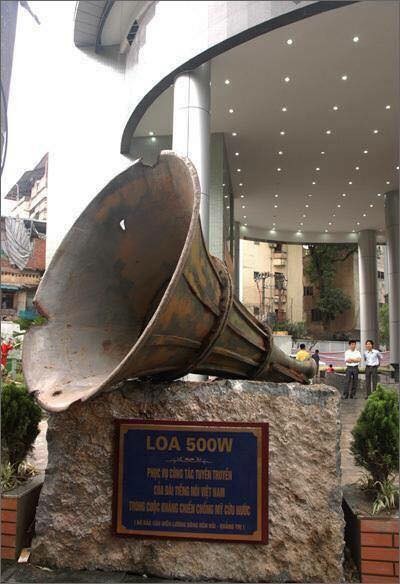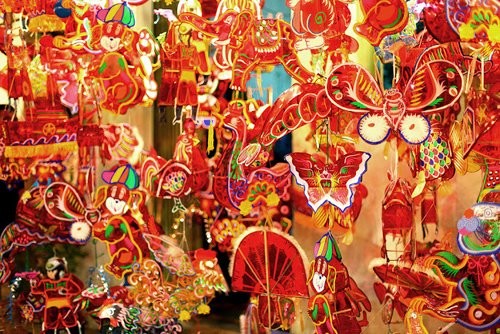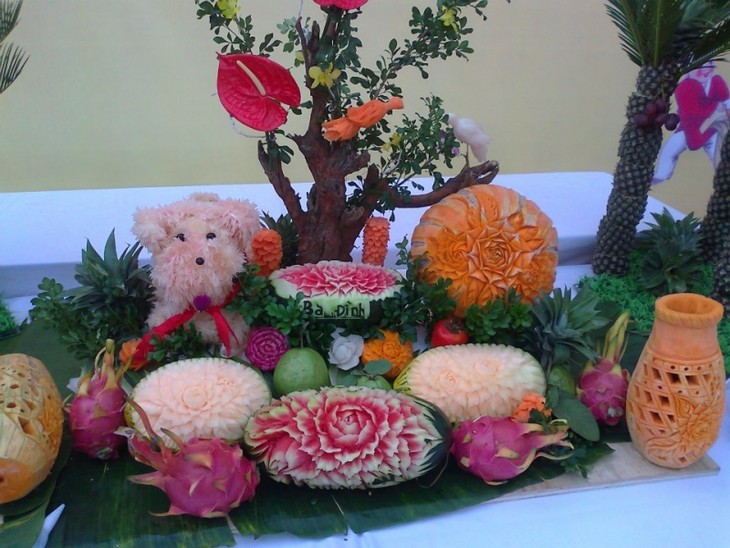A: First on our show today, we’d like to welcome Dmitry Elagin of Russia, who listened to our program on three frequencies: 7220 khz, 7280 khz, and 9730 khz and reported strong interference from a station in China.
B: Thank you, Mr. Elagin, for your detailed technical report. We’ll send you QSL cards to confirm your report. We hope to receive more feedback from you.
A: We’d like to say hello to Rasheed Naz of Pakistan. Naz says he is a new listener to VOV and is interested in VOV’s history.
 The Voice of Vietnam launched its first broadcast on September 7, 1945 The Voice of Vietnam launched its first broadcast on September 7, 1945 |
B: VOV’s first broadcast at 11:00 am on September 7, 1945, was of the Vietnamese Declaration of Independence being read by President Ho Chi Minh giving birth to the Democratic Republic of Vietnam, now the Socialist Republic of Vietnam. During Vietnam’s resistance wars against the French, VOV communicated Party and state guidelines and encouraged people throughout the nation to fight for independence and freedom.
A: VOV has been an important media organization in the vanguard of the ideological front. During the national resistance against the US, VOV served as a bridge between the front and the rear. Some of VOV’s programs contained coded orders from the Central Command in Hanoi to the southern fronts.
B: Over the past 73 years, the Voice of Vietnam, through its overseas programs, has mobilized world support for Vietnam’s liberation struggles and helped people get to know Vietnam, its land, people, culture and development.
A: In the current process of national renovation and integration, the Voice of Vietnam has developed 4 media platforms: radio, print, TV and online. VOV now has 7 radio channels including the News and Current Affairs channel- VOV1, the Education, Science, and Cultural life Channel- VOV2, the Music and Infotainment Channel- VOV3, the Ethnic Language Channel- VOV4, the World Service- VOV5, the Arts and Literature Channel-VOV6, and the VOV National Traffic Channel. The Voice of Vietnam also has 17 TV channels.
B: With more than 3,400 employees and domestic and overseas bureaus, the Voice of Vietnam continues to grow as a multimedia agency, providing news updates to audience in Vietnam and around the world.
 Lantern is the most favorite toy of children during the Mid-Autumn festival Lantern is the most favorite toy of children during the Mid-Autumn festival |
A: This week, many listeners to VOV asked about the celebration of the Mid Autumn Festival in Vietnam and typical food served at the festival.
B: The Mid-Autumn Festival is held on 15th day of the eighth lunar month to celebrate the biggest full-moon of the year. In Vietnam, this festival caters especially to children.
A: Moon cakes are delicious specialties of the Mid-Autumn Festival. Vietnamese moon cakes a different flavor from Chinese, Korean, or Japanese mooncakes.
B: The most popular shape is square or round, with a pattern on top that depicts flowers, fairies on the moon, carps admiring a full moon, and other fun things. Bakers sometimes bake cakes shaped like pigs, rabbits, and other animals.
 Mid-Autumn fruit decoration Mid-Autumn fruit decoration |
A: Vietnamese mooncakes have a thin, pastry crust enclosing a sweet, dense filling, which often contains one or more salted egg yolks, which symbolizes the full moon. The traditional filling contains lotus seed paste and ground meat but more modern mooncakes have a chocolate, green tea, green or red bean, sesame, or durian thing.
B: Vietnam has two main types of mooncakes: banh deo – white sticky rice cake and banh nuong - baked cakes. Banh deo, the white cake, is made of sticky rice and filled with a sweet mixture of lotus seeds, pumpkin seeds and green beans. Banh nuong, the brown cake, has a salty taste from a mixture of egg, pork fat, fried onions, peanuts and lemon leaves. Either cake can be round or square.
A: About a month prior to the festival, which falls on Monday this year, mooncakes go on sale everywhere. There is a trend toward making your own mooncakes for family and friends. Making homemade mooncakes is a fun way to teach children and foreigners about the cultural traditions of Vietnam.
B: Moon cakes are often given as gifts to friends, relatives, parents and grandparents. Vietnamese people put moon cakes and variety of fruits on the ancestral altar as an offering to their ancestors.
A: On the evening of the 15th day of the 8th lunar month, the whole family gathers around a tray of fruits and of course, moon cakes, and the adults tell their kids legends associated with the festival.
B: Kids attend art performances that include singing, skits, lion dances, drumming, and a procession of colorful lanterns, which winds through the streets and lights up the night.
A: The Mid-Autumn Festival emerged very early in Vietnam and has developed some unique features, but Vietnam’s festival shares features like moon cakes, lion dances, and lanterns with the festivals of other countries.
B: Here is an email from Najim Uddin who listened to our broadcast on September 12. He wrote: “In the Letter Box, you had wonderful information about the Lotus flower. It’s our national flower in India. Thank you for sharing this information.”
A: It’s interesting that lotus is the national flower of Vietnam and India as well. Regarding your question about Vietnam’s main folk dance, we’re afraid that we’ll have to leave the answer to the next show because of time constrains. Until then, we look forward to hearing more from you.
B: Didarul Iqbal of Bangladesh wrote: “We are proud to be the lucky audience of VOV. We also celebrated the 73rd founding anniversary of VOV on behalf of our South Asia Radio club with great pleasure. At the celebration ceremony, we discussed VOV’s history, goals, and objectives and its current programming activities. In Bangladesh, the VOV audience is steadily increasing due to our club’s promotional programs. We want to promote VOV more widely in Bangladesh so that VOV’s audience grow more and people can learn about Vietnam.”
A: Thank you, Mr. Iqbal, for tuning in to VOV. We appreciate the activities of your radio club.
B: We’d like to acknowledge letters and emails from Siddhartha Bhattacharjee, Ratan Kumar Paul, and Shayamal Kumar Banerjee of India, Fachri of Indonesia, and Richard Nowak of the US.
A: Thank you all for tuning in to VOV. We welcome your feedback at: English Service, VOVWORLD, the Voice of Vietnam, 45 Ba Trieu Street, Hanoi, Vietnam. Or you can email us at: englishsection@vov.org.vn. You’re invited to visit us online at vovworld.vn, where you can hear both live and recorded programs. Check out our VOV Media App available on both the IOS and Android platform to hear our live broadcasts. We look forward to your feedback on the mobile version of vovworld.vn. Once again, thank you all for listening. Good bye until next time.